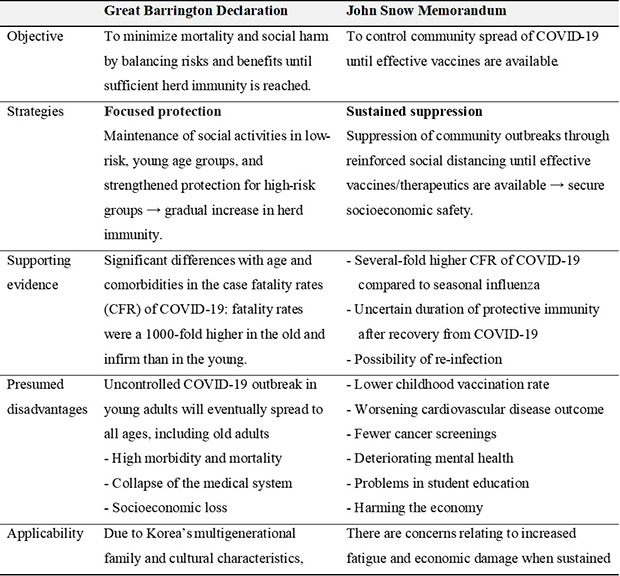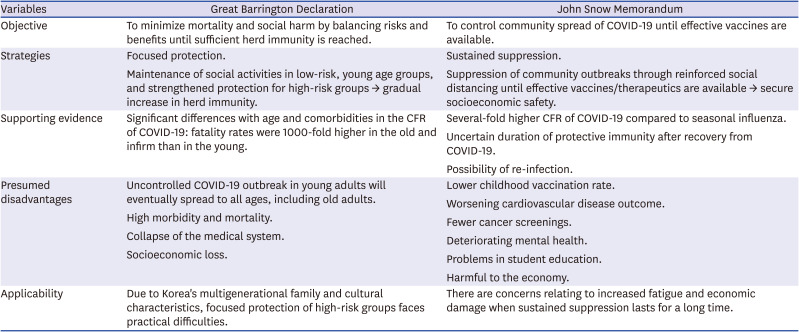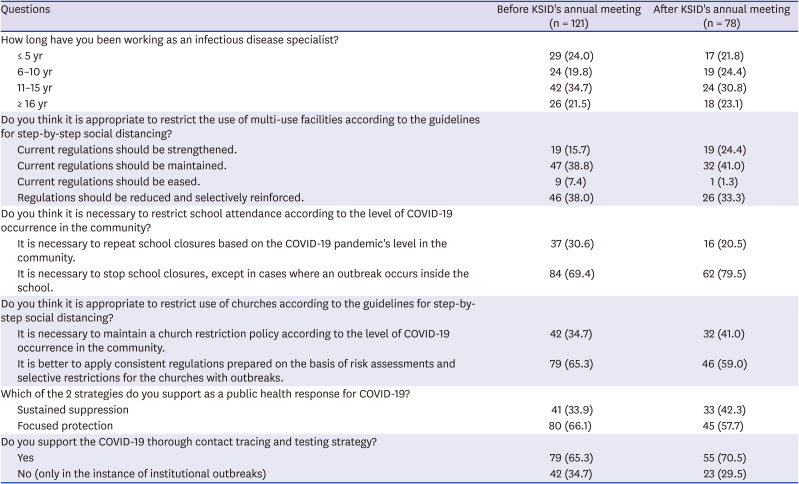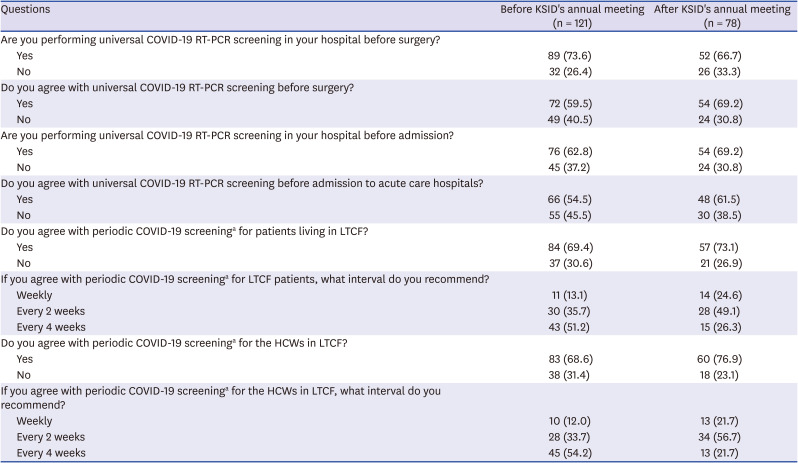Abstract
With the coronavirus disease 2019 (COVID-19) pandemic persisting for a long time, there have been debates about the public health response strategies. We conducted a survey of adult infectious disease specialists on public health responses to COVID-19. Most responded that regulations on multi-use facilities should be maintained or strengthened, but schools should not be closed, except in cases where an outbreak occurs within the school. A slightly higher percentage of experts supported focused protection rather than sustained suppression. While the focused protection strategy might suffice in low-level epidemic situations, social distancing should be reinforced by shifting to a strategy closer to sustained suppression in the eventuality of rapid spread of outbreaks.
Graphical Abstract

Severe acute respiratory syndrome coronavirus 2 (SARS-CoV-2) is highly contagious during its early stages of infection because of subclinical manifestations and early maximal viral shedding (short generation time), thereby spreading rapidly in a community.12 Moreover, there has been controversy over the possibility of airborne transmission among highly susceptible populations.34 Thus, SARS-CoV-2 has spread rapidly around the world, infecting over 61 million people globally and resulting in 1,433,316 deaths as of November 28, 2020.5 While most countries have maintained and strengthened their social distancing policies for the sustained suppression of coronavirus disease 2019 (COVID-19), some are implementing strategies to focus on protecting high-risk groups, continuing with socioeconomic activities. With the pandemic progressing for a long duration, there have been debates among experts about the public health response strategies to COVID-19. Eventually, two declarations supporting different strategies regarding these public health responses were released at the end of October 2020 (Table 1).67
As there appeared to be considerable disagreement among experts, the Korean Society of Infectious Diseases conducted a Google survey among adult infectious disease specialists (n = 265) on public health responses and hospital-level strategies against COVID-19 (Tables 2 and 3). The survey was conducted before and after the annual meeting of the Korean Society of Infectious Diseases (hereafter referred to as the meeting), focusing on COVID-19, and included public health responses and hospital infection control. Among 265 adult infectious disease specialists, 121 (45.7%) and 78 (29.4%) responded to the survey before and after the meeting, respectively. As expected, the infectious disease experts’ opinions were diverse and divided, with most responding that regulations on multi-use facilities should be maintained or strengthened (54.5% before and 65.4% after the meeting), and school attendance should be maintained (69.4% before and 79.5% after the meeting). Interestingly, the proportion of respondents supporting opening of schools increased after the meeting, while the proportion for sustained suppression increased. In a study using the decision analytical model to estimate the potential years of life lost because of the COVID-19 pandemic, school opening showed lower total years of life lost than school closure with a 98.1% probability.8 The decision analytic model considered the association between school closures and reduced educational attainment and also the association between reduced educational attainment and life expectancy using publicly available data sources. School closure should be determined after giving due consideration to the opinions of pediatric infections specialists and educational experts, as well as by considering the disease prevalence/severity and educational disruption of students age-wise. A slightly higher percentage of experts supported focused protection rather than sustained suppression (66.1% vs. 33.9% and 57.7% vs. 42.3% before and after the meeting, respectively). When stratified by their experience (≥ 11 vs. < 10 years) as infectious disease experts, a higher proportion of seniors than juniors supported the focused protection strategy, although the figures were statistically insignificant (67.6% vs. 64.2%, P = 0.703 and 64.3% vs. 50.0%, P = 0.253 before and after the meeting, respectively). Although a greater number of experts preferred focused protection over sustained suppression, most of them supported a thorough contact tracing and testing strategy for COVID-19. They seemed to consider that thorough contact tracing should be done to allow the outbreak situation to be controlled while allowing social activities and subsequent infections in young adults. As for the hospital-level countermeasures, 60% of experts supported universal COVID-19 screening before admission to acute care hospitals, but this could vary depending on the level of the pandemic outbreak in the community. Considering the high risk of COVID-19-related morbidity and mortality, more than 70% of the experts responded that patients and healthcare workers in long-term care facilities need periodic COVID-19 screening tests.
There are differences in the incidence of COVID-19 by country depending on the public health responses, such as school closure and social activity restrictions. However, after the COVID-19 pandemic is over, it would not be appropriate to evaluate the governmental response simply by the number of COVID-19 cases. It is compelling to identify ways to minimize public health loss while maintaining educational functions and minimizing economic damage. Rather than dividing the above-mentioned two public health response strategies (focused protection and sustained suppression) into black and white categories, both could be considered as strategic options depending on the specific situation. While the focused protection strategy might suffice in low-level epidemic situations, social distancing should be reinforced by shifting to a strategy closer to sustained suppression in the eventuality of rapid spread of outbreaks. If the COVID-19 pandemic continues for an extended period, various gray zone policies can be established while considering each country's specificity (social culture, population structure and density, international exchange activities, etc.) Moreover, it is necessary for high-risk institutions such as acute care hospitals and long-term care facilities to preemptively strengthen their levels of social distancing in the eventuality of the rapid progress of the pandemic.
ACKNOWLEDGMENTS
We thank all the survey respondents and members of the Korean Society of Infectious Diseases.
References
1. Petersen E, Koopmans M, Go U, Hamer DH, Petrosillo N, Castelli F, et al. Comparing SARS-CoV-2 with SARS-CoV and influenza pandemics. Lancet Infect Dis. 2020; 20(9):e238–44. PMID: 32628905.

2. Song JY, Yun JG, Noh JY, Cheong HJ, Kim WJ. Covid-19 in South Korea - challenges of subclinical manifestations. N Engl J Med. 2020; 382(19):1858–1859. PMID: 32251568.

3. van Doremalen N, Bushmaker T, Morris DH, Holbrook MG, Gamble A, Williamson BN, et al. Aerosol and surface stability of SARS-CoV-2 as compared with SARS-CoV-1. N Engl J Med. 2020; 382(16):1564–1567. PMID: 32182409.

4. Zhang R, Li Y, Zhang AL, Wang Y, Molina MJ. Identifying airborne transmission as the dominant route for the spread of COVID-19. Proc Natl Acad Sci U S A. 2020; 117(26):14857–14863. PMID: 32527856.

5. World Health Organization. Coronavirus disease 2019 (COVID-19): situation report. Updated 2020. Accessed November 28, 2020. https://www.who.int/emergencies/diseases/novel-coronavirus-2019/situation-reports.
6. Alwan NA, Burgess RA, Ashworth S, Beale R, Bhadelia N, Bogaert D, et al. Scientific consensus on the COVID-19 pandemic: we need to act now. Lancet. 2020; 396(10260):e71–2. PMID: 33069277.

7. Bhattacharya J, Gupta S, Kulldorff M. The Great Barrington Declaration. Updated 2020. Accessed November 19, 2020. https://gbdeclaration.org/.
8. Christakis DA, Van Cleve W, Zimmerman FJ. Estimation of US children's educational attainment and years of life lost associated with primary school closures during the coronavirus disease 2019 pandemic. JAMA Netw Open. 2020; 3(11):e2028786. PMID: 33180132.

Table 1
Comparison of 2 different public health responses to the COVID-19

Table 2
Questionnaire for future direction of public health responses for COVID-19

Table 3
Questionnaire for hospital-level countermeasures for COVID-19





 PDF
PDF Citation
Citation Print
Print



 XML Download
XML Download